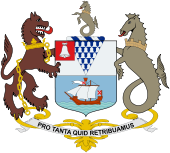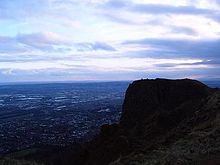- Cavehill
-
Cavehill Binn Uamha 
Elevation 370 m (1,214 ft) Location Location near Belfast, County Antrim, Northern Ireland Coordinates 54°38′49″N 5°57′04″W / 54.647°N 5.951°WCoordinates: 54°38′49″N 5°57′04″W / 54.647°N 5.951°W Climbing Easiest route Hike Cavehill, historically known as Ben Madigan (from Irish: Binn Mhadagáin), is a basaltic hill overlooking the city of Belfast in Northern Ireland. It forms part of the southeastern border of the Antrim Plateau. It is distinguished by its famous 'Napoleon's Nose'[1], a basaltic outcrop which resembles the profile of the famous emperor Napoleon and is said to have inspired the famous novel Gulliver's Travels.[dubious ] Cavehill is also the name of an electoral ward in Belfast.
All of Belfast can be seen from its peak, as can the Isle of Man and Scotland on clear days. Like Arthur's Seat in Edinburgh, it lies just a few miles from the centre of a major city.
Contents
Overview
Cavehill rises to almost 370 metres (1200 ft) above sea level. Most of its lower east side lies on the Belfast Castle estate, which has as its focal point the imposing 19th-century Scottish baronial castle. The castle was designed by Charles Lanyon and constructed by the Marquess of Donegall in 1872 in the Deer Park. The slopes of Cavehill were originally used as farmland but, from the 1880s, a major planting exercise was undertaken, producing the now familiar deciduous and coniferous woodland landscape. Belfast Castle estate was given to Belfast city by the 8th Earl of Shaftesbury in 1934.
The caves
There are three large caves. The lowest is 21 feet (6.4 m) long, 18 feet (5.5 m) wide and varies from 7 to 10 feet (3.0 m) in height. Above this is another cave; 10 feet (3.0 m) long, 7 feet (2.1 m) wide and 6 feet (1.8 m) in height. Above this is the third major cave, said to be divided into 2 unequal parts, each of which is more extensive than the larger of the other caves, but the ascent is notoriously dangerous and thus few venture to it.The caves are man-made, and it is postulated that they were originally excavated for iron-mining.
Adjacent to the lowest cave is 'The Devil's Punchbowl', also sometimes called 'The Devil's Cauldron', a site where ancient Celtic farmers corralled their cattle. This consists mainly of a steep hill, mainly of rocks and boulders, and is considered dangerous to amateurs.
McArt's Fort
This fort, on the summit of the hill, is an example of an old ráth or ring fort. It is protected on one side by a precipice and on the others by a single ditch, 10 feet (3.0 m) in depth and 25 feet (7.6 m) in width; a vallum of large dimensions. The enclosed area is nearly level. The flat top of the fort is 150 feet (46 m) from north to south, and 180 feet (55 m) from east to west.
It is believed that the fort's inhabitants used the caves to store white foods for the winter and may have served as a refuge during times of attack.
History
The hill was known in the original Gaelic as Beann Mheadagáin (meaning "Madigan's hill"), after one of two Kings of Ulaid: Matudán mac Muiredaig, who ruled from 839 to 857 A.D., or a later king, Matudán mac Áeda (reigned 937-950 A.D.). The later king's grandson, Eochaid mac Ardgail, was killed at the battle of Crew Hill in 1004, in which the Men of Ulster were defeated by their old enemies, the Cenél nEógain. It is from him that McArt's fort derived its name.
The residential neighbourhood at the foot of Cave Hill's entrance is derivatively known as Ben Madigan, with street names to match, and is a wealthy semi-outer city, semi-suburban area. The name 'Ben Madigan' can also be found attached to buildings, schools etc. close to the area, e.g. the Belfast Royal Academy has the Ben Madigan Preparatory School on the Antrim Road.
United Irishmen Theobald Wolfe Tone and Henry Joy McCracken allegedly met at Cavehill in 1795 to take an oath to launch the rebellion of 1798. McCracken was captured on Cavehill in 1798.
The crowning stone Giant's Chair of the O'Neill clan was apparently sited on Cavehill summit until 1896 and gave its name to the nearby Throne Hospital. The Cavehill Throne was destroyed by loyalists in December 1896 after a reference was made to it in an article in the nationalist paper 'Shan Van Bocht'. Parts of it may be available to view at the Ulster Museum.[citation needed]
During World War II, a bomb dropped prematurely during a German bombing raid on Belfast exploded, causing a large crater near the grounds of Belfast Castle. It is understood that RAF Bomber Command was situated on Cavehill in the early years of WWII before relocating to Castle Archdale in Fermanagh. Hence the German bomb may have been intentional.
On June 1, 1944, an American Air Force B-17 bomber crashed into Cavehill during heavy fog, killing all ten crew instantly. The incident inspired Richard Attenborough's film, Closing the Ring. Some scenes of the film were shot on Cavehill.
Geology
The hill owes it characteristic shape to Tertiary basalt lava flows, from 65 million years ago. This is underlain by Cretaceous—145 million years—Ulster White Limestone and below this is Jurassic—200 million years—Waterloo Mudstone Formation, more commonly known as Lias clay.
Limestone was mined on the southern flanks of Cavehill in Victorian times and transported to Belfast docks by way of a horse-worked railway along the Limestone Road. The railroad was abandoned in the 1890s. Two small hamlets—Daddystown and Mammystown—were built on either side of the railway track in the early 1820s as dwellings for quarry workers. Some of the local avenues and streets bear the name 'Waterloo', in reference to their geological origins.
Tourism and recreation
Cavehill Country Park, Belfast Zoo and Belfast Castle are magnets for locals and tourists alike. In the 18th century the townfolk of Belfast flocked there on Easter Monday for the Cavehill fete, near a spring known as the 'Volunteers' Well'. The summits offers stunning views southwards over Belfast City and Lough towards the Mourne Mountains, Scrabo Tower and Slieve Croob. On a clear day, the eastern prospect reveals views of Carrickfergus, the Mull of Galloway in Scotland and the Isle of Man.
See also
References
External links
- Belfast Parks
- Local public transport
- Discussion of Cavehill history
- Cavehill's appearances in literature
Belfast City Council General 
People District Electoral Areas Amenities Parks and gardens Cemeteries Balmoral Cemetery • Belfast City Cemetery • Clifton Street Cemetery • Roselawn CemeteryElections See also: Local government in Northern Ireland • CategoryMountains and hills of Ulster Antrim Hills 
Antrim Plateau Belfast Hills Croaghgorms Derryveagh Inishowen Mournes Sperrins Southwest Donegal Others Categories:- Areas of Outstanding Natural Beauty in Northern Ireland
- Mountains and hills of County Antrim
- Geography of Belfast
- Parks and gardens in Belfast
- Visitor attractions in County Antrim
Wikimedia Foundation. 2010.





